VOLKSWAGEN JETTA 2009 Owners Manual
Manufacturer: VOLKSWAGEN, Model Year: 2009, Model line: JETTA, Model: VOLKSWAGEN JETTA 2009Pages: 477, PDF Size: 77.6 MB
Page 381 of 477
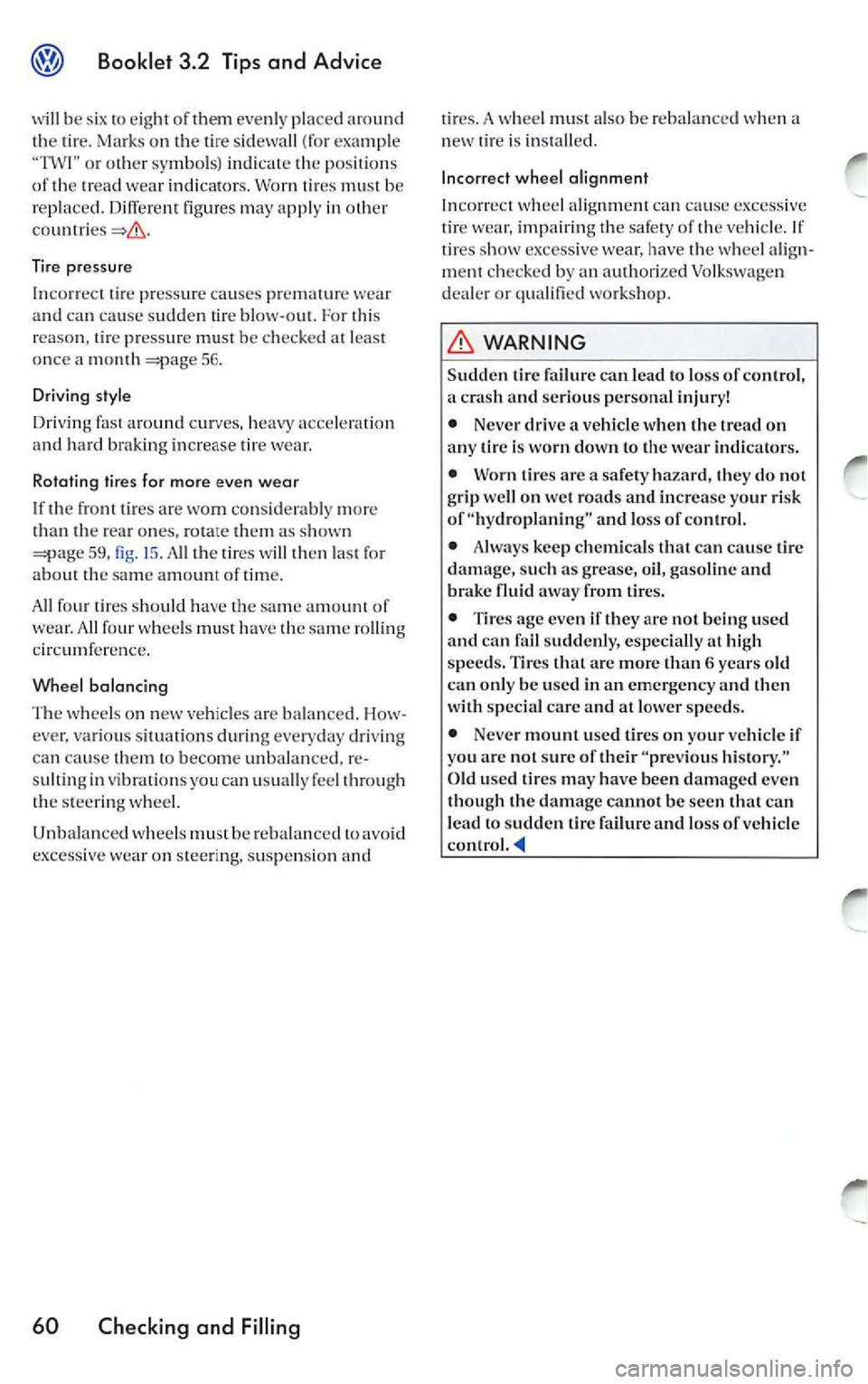
Booklet 3.2 Tips and Advice
will be s ix 10 eight of them evenly pla ced aroun d tire. Marks on the tire s idewa ll (fo r ex amp le o r oth er symbols) indicate the p ositions
of the tread w ear in dica tor s. Wo rn tires mu st be
rep laced . Different figu res may apply in oth er
Tir e pressure
In co rrec t lir e pr ess ure cause s pr ematur e wear
and can cause s udden tire blow -out. F or thi s
r easo n, tir e pressure must be c hec ke d at leas t
o nce a m ont h
56.
Driving style
Drivin g fast around cu rves, heavy acce lera tio n
and hard braking increase t ir e w ear.
Rotating tir es for more even wear
I f th e front tires are worn consid era bly m ore
than t he re ar ones, rotate th em as sh own
59, fig. 15 . All the tir es will then last for
about sa me of tim e.
A ll
tir es s hou ld have th e sam e am ount of
wear. All four w heels must have the sa me ro lling
ci rc umf ere nce.
Wheel balancing
Th e wh eels on ne w ve hicl es are balan ced. H ow
eve r. various situations during every d ay driv ing
can cause them
b ecom e unbalan ced, r e
s ultin g in vib rat io ns y ou can usuall y fe el throug h
th e steering wheel.
Unbalan ced w hee ls mu st be reb alan ced to avoid
e x cessive wear on stee ring, suspen sion and
60 Checking and Filling
tire s. A wheel also be rebalan ced w hen a
new lire i s in stalled .
In correct whee l alignment
Incorr ect whee l alignment can cause exc ess ive
ti re wea r, impa ir in g
safe ty of the ve hicle. If
t ir es s how excess ive wear, have wheel align
m en t ch ecke d by an authori zed Vol ksw age n
d ea le r or qualifi ed work sh op.
WARNING
Sud den tir e fa ilur e ca n le ad to lo ss of con trol ,
a cra sh and serious persona l injury!
• Neve r drive a vehicle wh en th e trea d on
any tire is wo rn dow n to the wea r indicator s.
• Worn tires a rc a sa fety hazar d, the y do not
gr ip we ll on wet roads and increase y our risk
of "h yd ropl anin g" and lo ss of contro l.
• Always kee p ch emi cals that can ca use tir e
d amage, s uch as g rease, oil , gaso line and
brak e fluid away from tire s.
• Tire s age even if th ey a rc not b ein g use d
and can fail sudd enl y, es pecially al high
s pe eds . Tir es that a re more than 6 year s old
can onl y be use d in an emergen cy and th en
w ith sp ecia l care a nd at lowe r sp eeds.
• Neve r mount u sed tire s on your vehicl e if
you a rc not sur e of their "pr ev iou s hi stor y."
Old use d tir es ma y ha ve been d amaged eve n
th ough the d am age ca nnot b e seen that can
lead t o sudd en tir e failure and loss of vehicle
Page 382 of 477
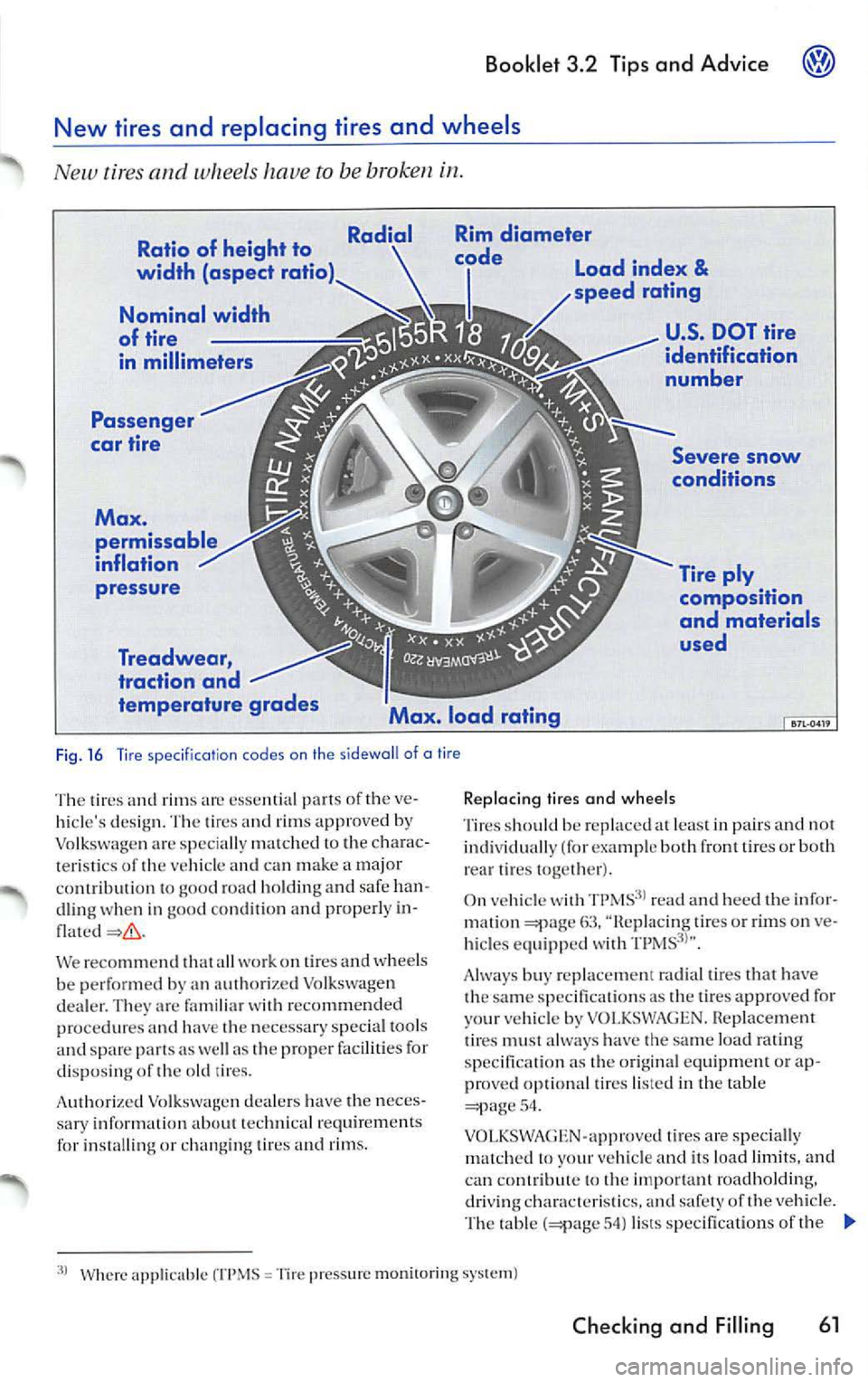
Booklet 3 .2 Tip s and Advice
ply
Max . load rating composition
and mater
ials
used
Fi g. 16 Tir e spec ifica tion codes on the sid ewa ll of tire
The rires rims es sen tial parts of the vedesig n . Th e tire s and rim s approved by
V ol kswage n ar e s pecially matched the cha rac
teri sti cs o f veh icle ca n make a major
co ntribution to g oo d ro ad holding and saf e han
d ling when in good co ndition an d prop erly in
We reco mmen d on tir es and w heel s
be perfor med b y an aut hori zed Volk swage n
dea le r. Th ey are
wi th re com men d ed
p roced ure s and have the necessary specia l tool s
a nd spare parts as we ll as the proper facilities for
di spo sing of th e old tire s.
Vo lk sw agen deale rs ha ve the nec es
s ar y in for mati on abo ut technical requ ire m ents
for in sta llin g or
a nd rims.
Rep lacing tires and whee ls
s h ou ld be re placed leas t in pairs and not
individuall y (for exa mple both fron t tir es or both
rea r tir es toge th er ).
On v ehicle with
re ad and heed th e infor
m atio n tire s or ri ms on ve
hi cles equipp ed
buy re pla cement ra dial tire s that ha ve
th e same sp ecificat io ns as th e tir es appro ved for
your vehicl e by VOLK SW AGE N. R epla cement
t ire s m11 s1 alwa ys have the sam e load rating
s p ecificat ion a s the ori gin al equipm en t or ap
p rove d optio nal tire s listed in th e tab le
5 4.
VOLK SWAGE N-approved t ires are speci all y
matched 10 your veh icle and its load limit s, and
ca n co ntr ibute 10 1 he impo rtan t roadholding ,
driving chara cte ri sti cs , and sa fety of the vehicle.
T he
54) lists s peci ficat ions of t he
Wher e app lic a b le (T l'M S Tire pre ssure moni toring
Checkin g and Fillin g 61
Page 383 of 477
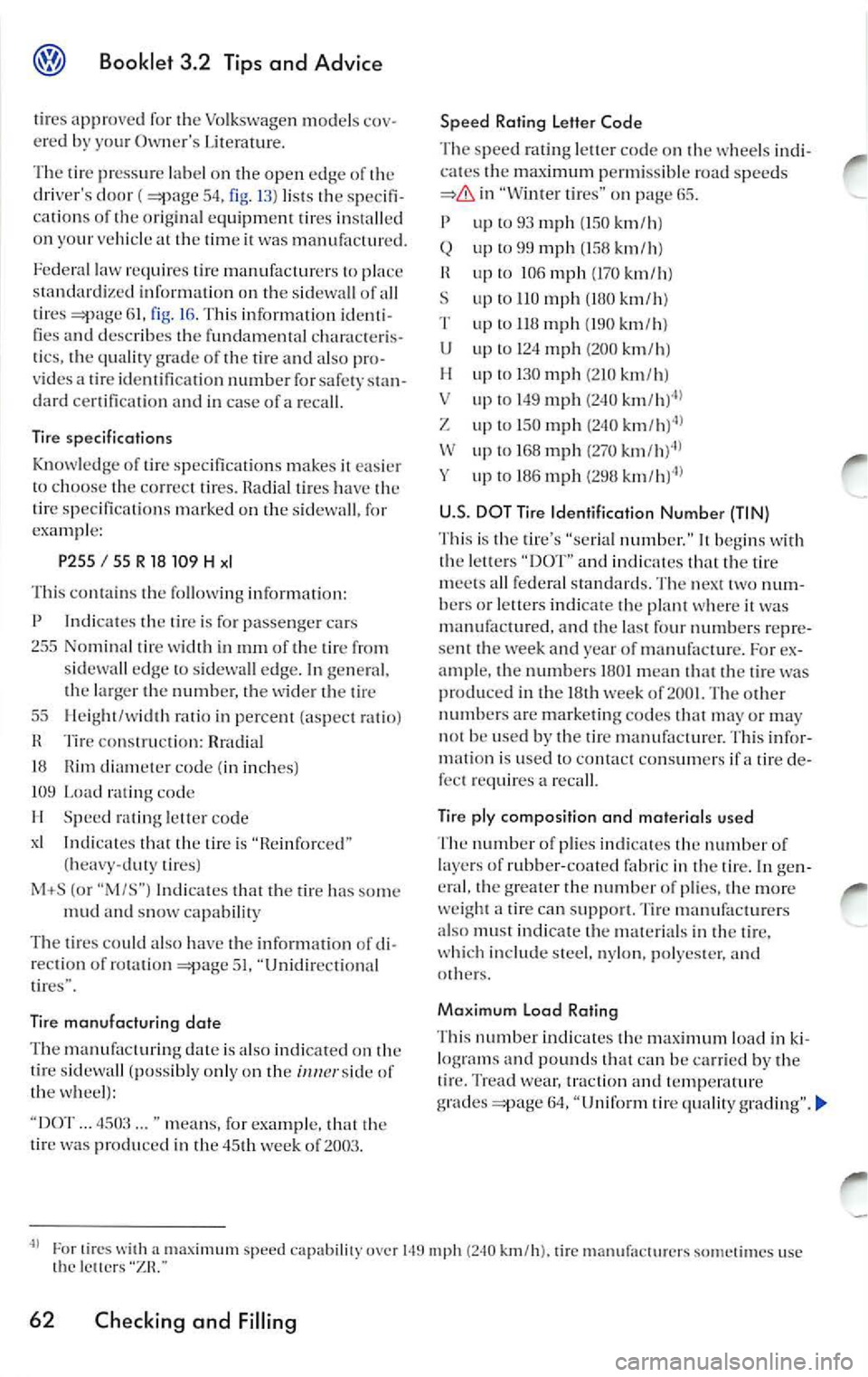
Booklet 3.2 Tips and Advice
tires approved for the Volkswage n models ered by your Owner's Literature.
The tire pressure label on the open edge of the
dri ver's door (
54, fig. 13 ) lists th e s pec ifi
cations of the original equipm ent tir es insta lled
on your vehicle at the time it was
Federal law re quire s tire manufacturers to plac e
standardized informat io n on the sid ew all of all
t ir es
fig. This information id enti
fi es d esc ribes the fundamental charac te ris
ti cs, the quality grad e of the tire and also pro
vides
tir e id entifi cation number for safe ty stan
dard certificat ion an d in case of reca ll.
Tire specifications
Kn ow le d ge of tire sp ec ifica tions mak es it easier
to choose the tires. Hadial tires ha ve the
t ir e sp ec ifica tion s mark ed on th e sidewall, for
examp le :
P255 I 55 R 18 109 H x i
This contain s the following information:
Indi cates the tir e is for pass enger
No minal tire width in mm of the tire from
s ide wall edg e to sidewa ll edge. 1 n general.
th e lar ger the numb er, the wider th e tir e
55 I !e ight /width
in per cent (aspect ratio )
Tire constru ctio n: Hrad ial
1 8 Him diamete r
(in inch es)
109
co de
Speed le tter code
x i
tha t th e tire is "R einf orced"
( h eavy-d uty tir es)
M +S (o r "M /S") Indicates that t he tire h as some
m ud and snow capabili ty
The tire s could al so have the information of di
rection of rotation
51, "Unidi rectiona l
tires".
T ir e manufactur ing date
The manufa cturin g dat e is also indicate d on the
tir e sid ewa ll (poss ibly o nly on the i1111 erside of
th e wheel):
... 45 03 ... "means. fo r exam ple, that th e
tir e produ ced in the 45th week of
Speed Rating Letter Code
The sp ee d rating le tt er code on the wheel s indi
cates the maximum p ermi ssibl e roa d speeds
in "Wint er tires" on page
up 93 mph (150 km/h )
Q 99 mph km/h)
up to 106 mph (170 k m/h)
s up to llO mph (180 km /h )
T up
118 mph (190 km/h )
u up t o 124 mph (200 km/h )
up to 130 mph (210 km /h )
V up to 149 mph (240
up to 150 mph (240
\V up t o 168 mph (270 y
up to mph (298
U. S. DOT Tire Identification Number (TIN )
Thi s is the tir e's "se rial number." It begins with
th e le tt ers "DOT" and indicates
the tire
m ee ts all federal standards . The n ext two
ber s or lett ers indicate th e plant where it was
manufacture d. and the la st four numb ers repre
se nt the week and year of manuf acture. For ex
a mpl e. th e numb ers 180 1 m ean that the tire
produ ced in the 18th week of 2001. The oth er
numb ers are mark etin g co des ma y or ma y
n o t be used b y th e tire manufa cturer. T his infor
mati on is u sed to contact consum ers ifa tire de
f ec t req uires a reca ll.
Tir e ply compos ition and materials used
T he numb er of plies indicat es the numb er of
la ye rs of rubb er-co ated fabri c in the tir e. In gen
e ral, th e g rea te r the numb er of p lies , th e mor e
a tire can supp ort. Tire manuf actur ers
a lso mu st indicate the materials in the tire ,
wh ich include steel. nylon, poly este r, and
o th ers .
Maximu m Load Ra ting
Thi s numb er indi cat es the maximum load in ki
lo gram s and pounds that can h e
by the
tir e. Tread wear, traction and te mpe ralll re
g rades
64, tir e quality
·II For tir es max imum speed capabilit y over mph (240 km /h ). tire so metimes use
th e lette rs
62 Checking and Filling
Page 384 of 477
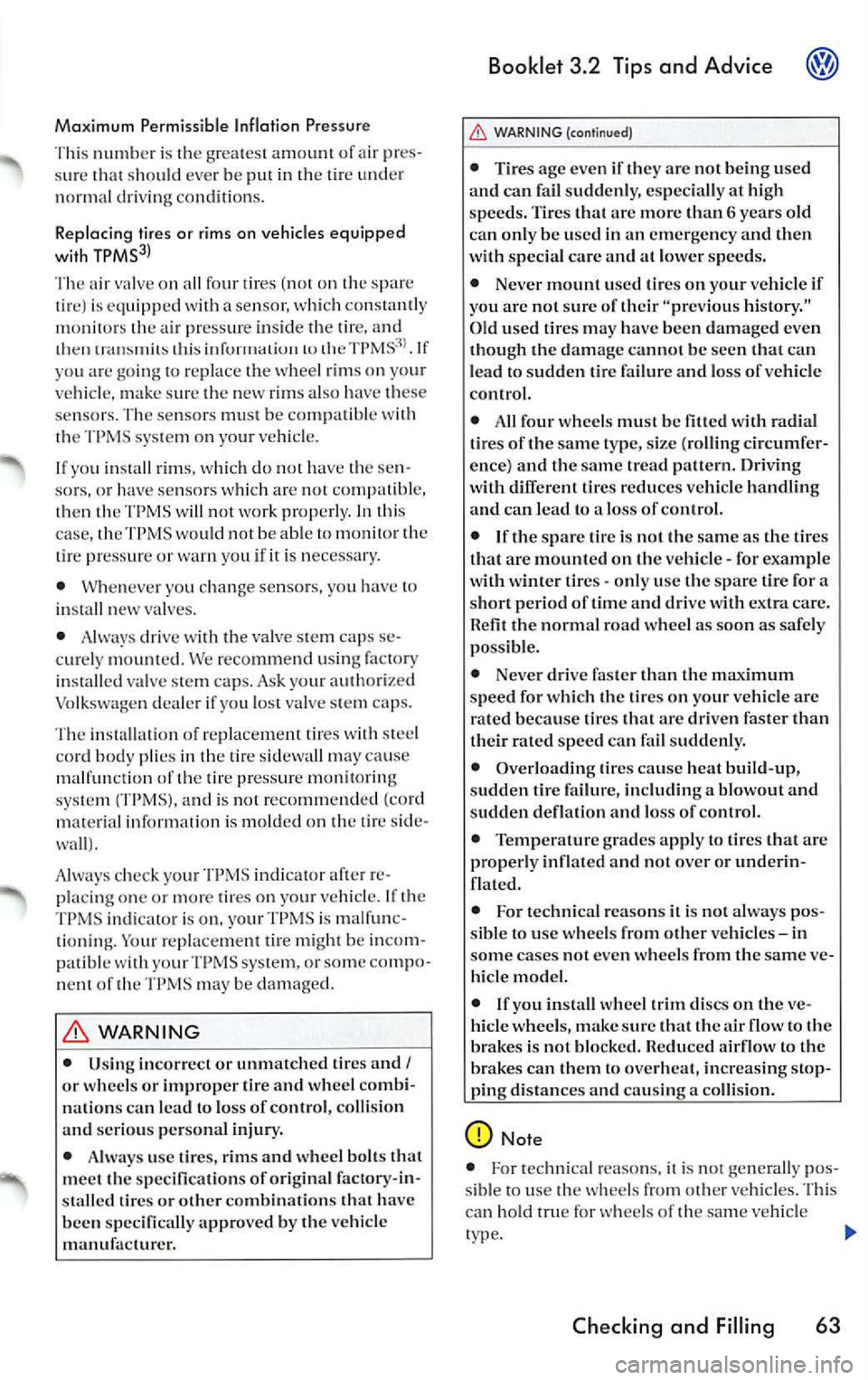
Maximum Perm issib le Inflatio n Press ure
T his nu mb er is th e g re at est a mount of
pres
s ur e tha t sh oul d ever be put in the tire und er
norma l driv ing cond itio n s.
R ep lac in g tires or rims on vehicles equipp ed
wit h
The air va lve o n all four tires (no t on the spare
ti re) is equip ped with a senso r, w hic h co nsta ntly
m on itors
a ir pr ess ure in side the tire, a nd
the n this Lu If
yo u ar e going to re pl ace the wheel rim s o n yo ur
ve hicl e, make sure the rim s also have these
se nso rs. The se nsor s mu st be co mp atib le w ith
TPM S sys tem o n yo ur vehicle .
I f yo u install rim s. w hich do not have th e se n
sors, o r ha ve sensors w hich are not comp ati ble,
th e TP MS will not wor k pro perl y. In case, theTPM S would n ot b e ab le to m oni tor pr ess ure or wa rn you if is necessa ry.
• Wheneve r you c hange se nso rs, yo u ha ve to
i n sta ll
valves.
•
dri ve the valve ste m cap s se
c ur ely m ou nted. We reco mmen d usi ng fac to ry
i n sta lle d va lve stem caps. As k your auth ori zed
Volkswage n dea le r if yo u los t va lve
caps.
T he in sta llat io n of re pla ceme111 tires
c ord hody plies in the tire si dewa ll m ay ca use
ma lfu nction tir e pre ssure monitorin g
sys te m (TPM S), and i s not recommended (cord
mat eri al informatio n is m olded on
ti re s ide
wa ll).
ch ec k yo ur TPM S indi cator af te r r eone or more tires o n yo ur vehicl e. If t he
TP MS indi cator is on. your TPMS is m alfu nc
ti o nin g. Your
tire m ig ht be incom
patibl e yourTP MS system, or some co mp o
n en t of the TP MS may be dam aged .
WARNING
• Usin g in cor rect or unmatched tires and
I or wheels or improper tire and whee l co mbi
nation s can le ad to loss of con tro l, co llisio n
and serio us perso nal injury.
• Always use tires, rims and whee l bo lts th at
me et th e specification s of ori ginal fa ctory- in
s talled tire s or other combination s th at h av e
b een sp eci fica lly app roved by the vehicle
manufa ctur er.
Booklet 3.2 Tips and Advice
WARN ING (continued)
• Tire s age even if they arc not being use d
and can fail su ddenl y, es peci ally at high
s peeds. Tire s th at are more than 6 yea rs old
can only be use d in an em ergenc y and then
w ith specia l care and at lower speeds.
• Never mount use d tir es on your vehicle if
yo u are not sur e o f th eir "previou s hi story."
Old used tir es ma y ha ve bee n damag ed even
th ou gh th e dam age ca nnot be seen that ca n
l ead to sudd en tir e fa ilur e and lo ss of vehicl e
control.
• All four whe els must be fitted with radi al
tir es of the s am e type, size (ro lling cir cumf er
ence) and th e sa me tread p attern. Dri ving
w ith diff erent tire s reduces ve hicle han dling
a nd can l ead to a loss of control.
• If the spare tire is not th e same a s th e tir es
that are mount ed on the vehicle - for examp le
with winter tir es - only u se the sp are tir e for a
s h ort period of tim e and drive w ith extra care.
Refi t th e no rma l road w hee l as soo n as safe ly
possib le.
• Neve r dri ve
than th e spe ed for wh ic h th e tires on you r ve hicle are
rat ed because tires that arc driven fas te r than
their rated sp eed ca n
sudd enly .
• Overloadin g tir es cause h eat build -up ,
s ud den tire failur e, includin g a blowout and
sudden defl ation and loss of co ntrol.
• Temperat ure grades apply lo tir es that are
properl y inflat ed and not over o r underin
flated .
• For tec hni cal reaso ns it i s not always pos
s ibl e to use whee ls from oth er ve hicles-in
s om e cases not eve n whee ls from the sa me ve
hicle model.
• If you insta ll w hee l trim d iscs on th e ve
hicle whee ls, make sur e that th e air flow to the
brakes is not blo ck ed. R edu ced airflo w to the
brakes can th em to ove rheat , in cre asin g sto p
ping distances and causin g a colli sion .
Checking and Filling 63
Page 385 of 477
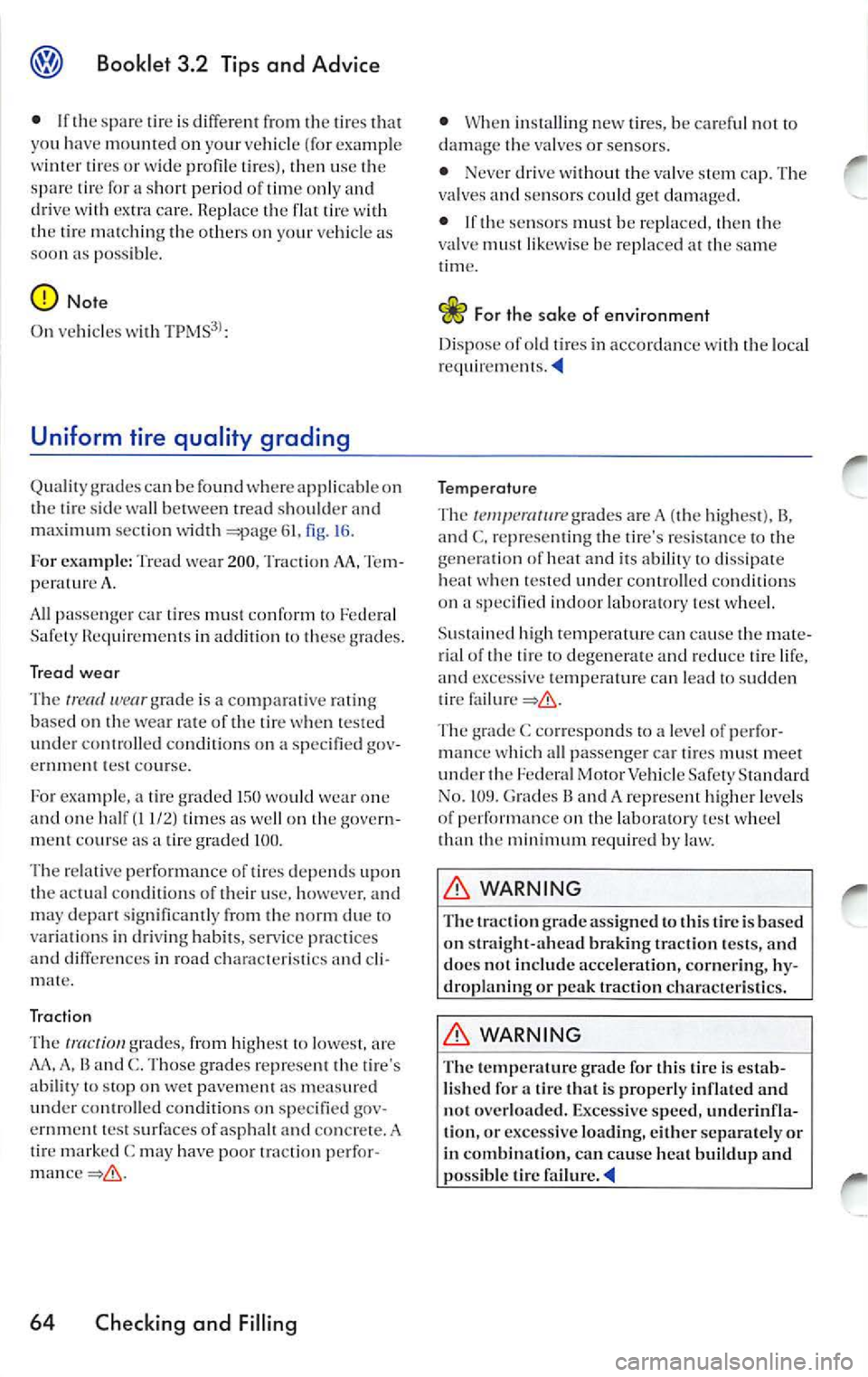
Booklet 3.2 Tips and Advice
• If the spar e tire is differe nt from the tires that
yo u have mounted on your ve hicl e ( for example
tir es or wide profil e tir es), then use the
spare tire for a sh ort period of on ly and
driv e w ith extra care . R ep lace the flat tir e wi th
th e tir e ma tc hin g th e o ther s on yo ur vehicle as
soo n as pos sibl e.
Uniform tire quality grading
Qualit y can b e found w here appli cable on
th e tire side be twee n tread sh ou ld e r and
m axi mum sec tion w idth 61. fig . 16 .
For exampl e: T rea d wear 20 0, T ra ctio n /Ill, Te mII.
1111 pa sse nger car ti res must conform to Federa l
Safe ty Hcquirem ents in additi on t o grade s.
Tr ead wea r
The
specifi ed gov
ernme nt test course .
F or examp le ,
tir e g raded 150 wou ld wea r on e
and one half (11 /2) tim es well on govern
me nt course as a tire graded IOO.
T he re lat ive perfor mance of tires depend s up on
th e act ual co nditions of the ir use, however. and
m ay depa rt sig nifi cantl y from th e no rm du e to
va riat io ns in dri vin g ha bits, se rvice practic es
a nd diff ere n ces in road chara cte ri sti cs and cli
grade s, from hig hes t to lowes t. are
AA . and C. Those grade s re pr ese nt the tir e's
a bilit y to stop on pav ement as m easure d
under controlled condit io ns on spec ified gov
e rnment
surfa ces of asp halt and concret e. A
ti re m ark ed C ma y ha ve poor tracti o n perfo r
64 Checking and Filling
• in sta llin g new tires, be c are ful no t t o
dam age the va lves o r sensor s.
• Never drive witho ut the va lve ste m cap. Th e
va lves a nd senso rs
get dama ged.
• I f
sensors must be rep la ce d, th e
va lve must likew ise be re pla ced sa m e
tim e.
c£> Fo r the sak e of environment
Di sp ose o f o ld tires in accordan ce wit h th e loca l
r e qu ire m ent s.
The 1e111pem111re grades are A (the hi ghes t), B. an d C. represen ting th e tir e's to the
gene ration of heat and its abi lity 10 di ss ipat e tes te d und er contro lled co ndi tions
on a spcci f'ied indoo r lab oratory te st w heel.
Sus tained hig h tempera ture ca n cause
mate
r ial of the lir e to deg enerat e and re du ce lire life,
and excess ive te mperature can lea d to sudd en
tir e
The C co rresponds to a leve l of perfor
m an ce whi ch all pa sseng er car tires mu st m eet
un der the
Motor V ehi cle Sa fe ty Standard
No. G rad es and A re pres ent higher lev els
of pe rfo rm ance on the laboratory w heel
th an minimu m re quir ed by law.
WA RNING
The trac t ion gra de ass igned to thi s tire is base d
on stra ig ht-ah ead brak ing tra ctio n t ests, and
d ocs not i nclude acceleration, corn erin g, hy
d ropla ning or peak tracti on cha racter is ti cs.
WARNING
Th e te m pera ture gra de fo r thi s tire is es ta b
li sh ed for tir e th at is proper ly in fl ated and
not overloaded. Excess ive spee d, und crinfl a
tion , or excess ive load ing, eith er separate ly or
in com binati on, ca n ca use hea t bu ildup and
po ssible tir e fa ilur e.
Page 386 of 477
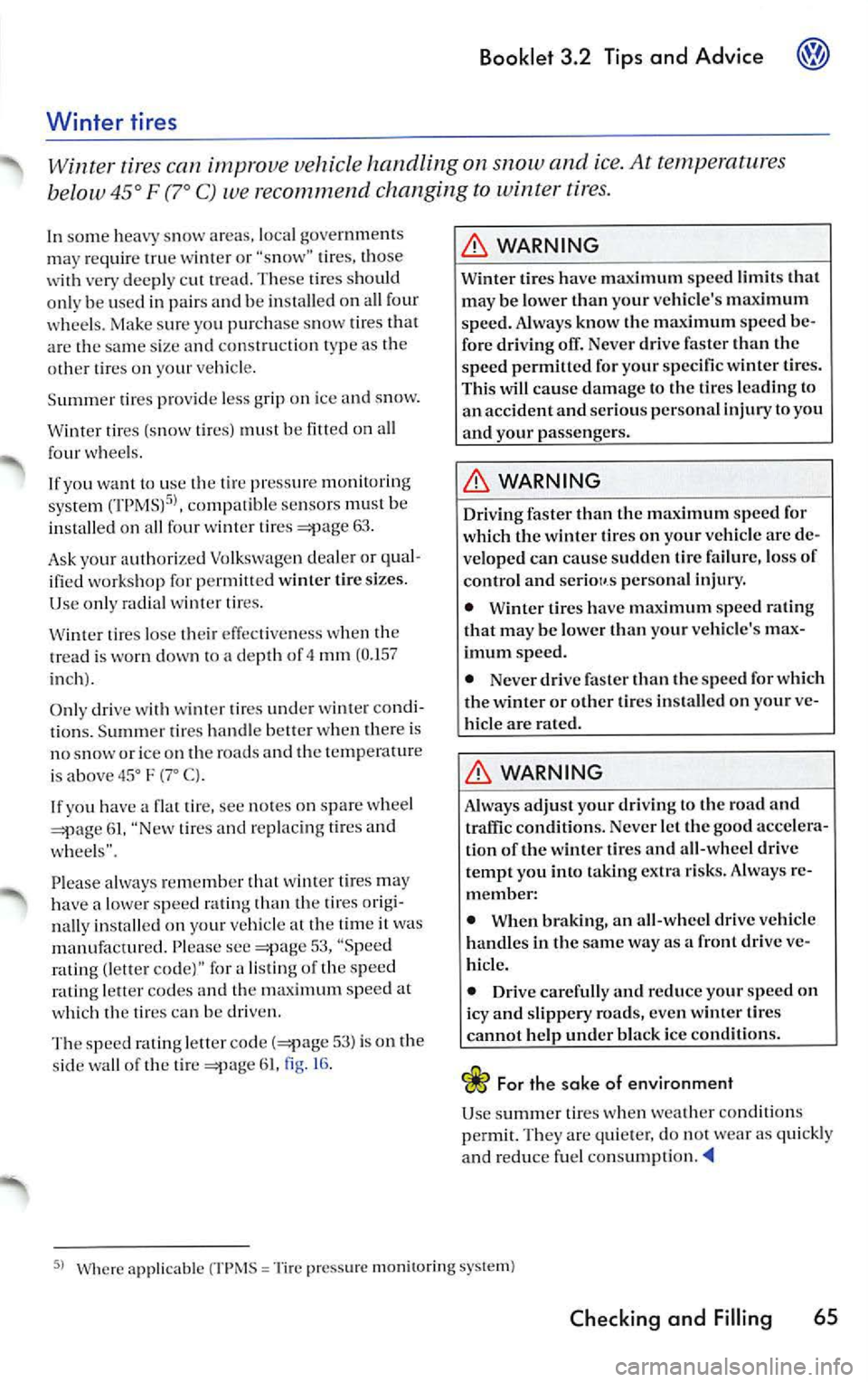
Booklet 3.2 Tips and Advice @
Winter tires
Winter rires can improve vehicle handling on snow and ice. At temperatures
below 45 ° F (7 ° C)
recommend changing to winter tires.
In som e hea vy s now areas, loca l go vernment s
m ay re quir e tru e or "snow" tires, those
wit h very deepl y cut trea d. The se ti res sh ould
on ly be use d in pair s and be in sta lled on all four
w hee ls. Make sur e yo u purcha se snow tire s that
ar e th e s am e size and const ruction ry p e as the
othe r tir es on your vehicl e.
S umm er tire s prov ide less grip on ice and sno w.
Winter tires (s now tires) must be
on a ll
four whe els .
If you wa nt to us e th e tir e pre ssure monitoring
sys tem
compat ibl e se nso rs mu st b e
in sta lle d on all four wint er tire s 63.
Ask your authori zed Volkswage n deal er or qual
ified work shop for permitt ed winter tire sizes.
U se on ly rad ia l w int er tir es.
Wi nter tires lose their effectiveness w hen the
tr ead is worn dow n
to a depth of 4 111111 (0.1 57
inch ).
Onl y driv e wit h wint er ti res und er w int er co ndi
tion s. S umm er tir es hand le bett er w hen there is
no snow or ic e on the ro ads a nd th e temp erature
is above 45 ° F (7 ° C).
If yo u ha ve a flat tir e, see notes on spar e w heel
"New tires and replaci ng tire s an d
wh eels".
Pl eas e always re m emb er that winter tir es ma y
ha ve a lower spe ed
than th e tire s origi
nall y insta lled on your vehicl e at the time it was
manufactur ed. Pl ease see
53, "Spee d
rating (letter cod e)" for a listing of the spe ed
rating l ett er co de s and
maximum speed ar
w hi ch the tires c an b e driv en.
The sp eed rating letter code
53) is on the
s id e w all of th e tire fi g . 16 .
WARNING
Winter tires have maximum speed lim its that
may be lowe r than your vehicl e's maximum
speed. Always know the maximum speed b e
fore driving
Neve r drive fa ster than the
speed permitted your speci fic wi nter tires.
This cause damage to the tire s leading to
an accident and serious personal injury to you
and your passengers.
WARNING
Driving faster than the maximum speed for
which the winter tires on your vehicle are
veloped can cause sudden tire failure, loss o f
contro l and seriot• .s personal injury.
• Winter tire s have maximum sp ee d rating
that may be lower than your ve hicle's max
imum speed.
• Neve r drive fa ster than the sp eed for which
the wint er or other tires installed on you r
hicle are rated.
WARNING
Always a djust your driving to the road and
traffic condition s. Never let the good accelera
tion of the winter tir es and all -wheel drive
tempt you into taking extra risks. Alway s
member:
• When braking, an all-w hee l drive ve hicle
h andles in the same way as a front drive
hicle.
• Drive carefu lly a nd reduce yo ur speed on
ic y and slippery roads, eve n winter tire s
cannot help un der black ice conditio ns.
Fo r the sake of environment
U se s umm er tire s wh en weat her condition s
permit. The y are qui ete r, do not wear as qui ckl y
and redu ce fuel consumpti on
Where applicabl e (TP MS = Tir e pre ssure mo nitoring system)
Checking and Filling 65
Page 387 of 477
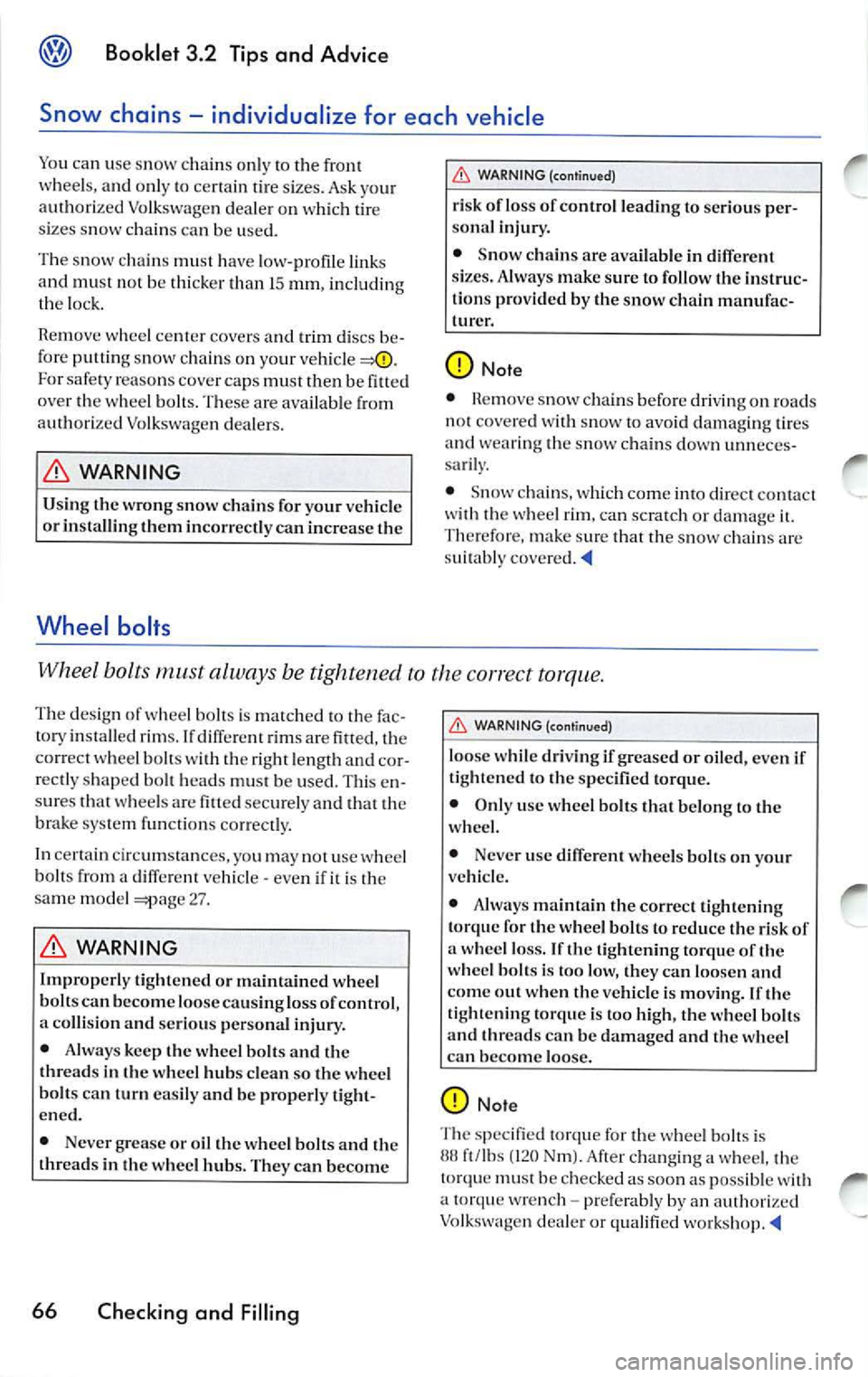
Booklet 3.2 Tips and Advice
Snow chains - individualize for each vehicle
Yo u ca n use s now cha ins only to th e front
whee ls , and only t o certain tire sizes . Ask your
author ized Vo lk swage n deale r on which tir e
s ize s snow c hain s ca n be use d.
T he sn ow chain s must have low -profil e link s
and must n ot b e thi ck e r than 1 5 mm, including
th e loc k.
R emove whe el ce nter cove rs a nd trim discs be
fo re pulli ng s now c hain s on yo ur
For safe ty re a so ns cove r caps must then be ove r th e w hee l b olts. Th ese are a vailable from
a uth ori ze d Vo lkswage n deal ers .
WARNING
U sin g the wrong snow chains for your vehicle
or in stalling them incorrectl y can increase the
Wheel bolts
WARNING (continued )
risk of l oss of contro l leadin g to seriou s per
s onal injury.
• Sn ow c hain s are available in differen t
s izes. Always make sure to follow the in stru c
tion s provided by th e snow chain manufac
turer.
wi th the whee l rim , ca n scratc h or da ma ge it.
T herefo re, make s ure that the s now chain s are
s uit ably
Wheel bolt s must always be tightened to the correct to rque.
The des ig n of w hee l bolt s is m atc h ed to th e facto ry in sta lled rim s. If diff erem rim s are fitted, the
co rrec t whee l b o lts wi th th e right le n gt h and cor
rec tly s hap ed bolt heads must be u sed. This en
s ure s that whee ls a re fitt ed sec urely and that the
b rake syste m f unctio ns co rrec tly.
l n certain cir cum sta nces, yo u may no t u se w hee l
bo lts from a diff ere nt vehi cle -eve n if it is th e
sa me mode l
27.
WARNING
Improp erly tightened or maint ained wheel
bolt s can become loose ca using lo ss of con trol,
a colli sion and se ri ous perso nal inju ry.
• Alwa ys keep th e wheel bolt s and the
th rea ds in the whee l hubs clean so th e wh eel
bolt s can turn easily a nd be properly tight
ened.
• Neve r gr ea se or oil the w hee l bolt s and the
threads in the wheel hubs. They can be come
66 Checking and Filling
WARNING (continu ed)
loose w hile dri ving if greased or oiled, eve n if
ti ght en ed to the specified torque.
• Onl y use whee l bolt s th at belong to th e
w hee l.
• Neve r use diff erent whee ls bolt s on your
ve hicle.
• Alway s maintain the co rrect ti ghtenin g
torque for the wheel bolts to re duce the risk of
a wheel los s. If the tight ening torqu e of the
w hee l bolts is too lo w, they ca n loosen and
co me out when the ve hicle is mo vin g. If the
ti ght enin g torqu e is too hi gh , th e w hee l bolt s
a nd thread s can be damaged and the w hee l
ca n be come loo se.
The sp ecified to rq ue for the w heel bolts is
88 ft/lbs (120 N m). Afte r chan gin g a w hee l. th e
t o rq ue mu st b e checked as soo n as poss ib le w ith
torq ue wre nch - p refera bly by an auth ori zed
Vo lkswage n dea le r or qualifi ed
Page 388 of 477
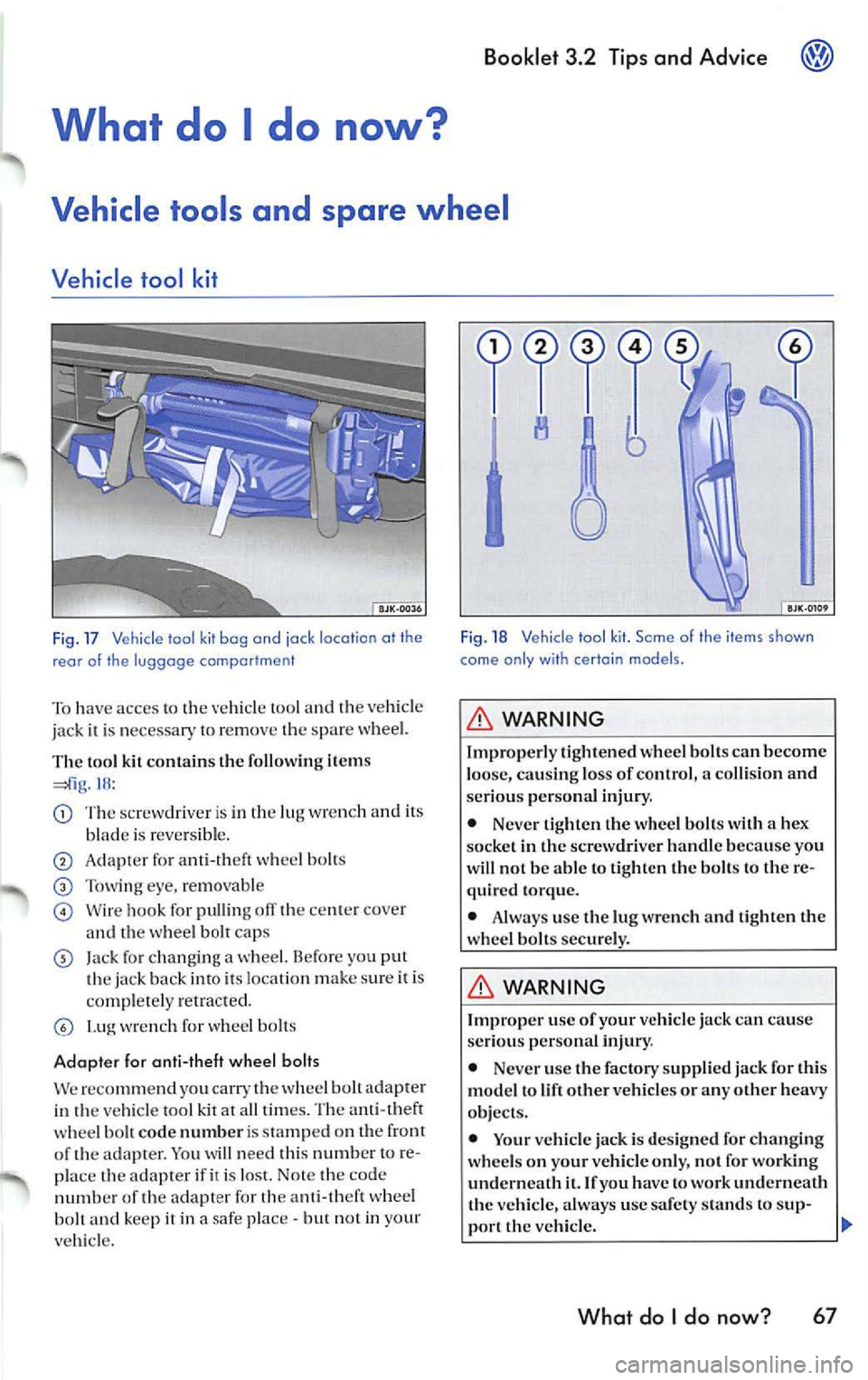
Booklet 3.2 Tips and Advice
tool and th e vehicl e
jack
con tains th e follow ing items 18 :
Th e sc rew driv er is in th e lu g w re nch and its
b lad e is re ve rs ib le .
A dap ter for ant i-th eft wh eel bo lts
Tow ing eye, re movab le
W ire hook for pulling off the ce nte r co ve r
a nd th e w he el b olt cap s
Jack f or changing a wheel. B efor e yo u put
th e jack back in to i ts loca tion make sur e it is
co mp le te ly re tr a cted.
wr en ch for wheel bolts
Ad opter for anti-th eft w hee l baits
We reco mmend yo u carry t he wh eel bolt adap te r
in th e ve hicle tool kit at all times. The a nti-theft
w hee l bo lt code numbe r is sta mp ed on th e front
of th e ada pter. Yo u will need this numb er to re
p lace t he ada pter if it is lo st. No te th e c ode
numb er o f th e adapt er fo r th e an ti- th ef t whee l
b olt and kee p it in a safe pla ce
but not in your
veh icle.
Fig . 18 Vehicle too l kit. Some of th e it e m s sh own
come o nly w it h certa in models .
WARNING
Improper ly t ighte ned whee l bo lts can become
l oose, ca usi ng loss of contro l, a co llisio n an d
ser ious perso nal i nju ry.
• Neve r tig h te n th e w hee l bo lts wit h a hex
socke t in th e sc rew driver h and le because yo u
w ill n ot be ab le to tig hte n th e bo lts to t he re
qu ired torque.
• Always use t he lug wrench and tig ht en th e
wh eel bolts secure ly.
WARNING
Imp roper use of your ve hicle jack can ca use
ser io u s pe rso nal in jury .
• Never use the fac tory sup plied jac k for t his
mod el to lift othe r ve hicles o r any other heavy
ob jec ts.
• Your vehicle jac k i s des igned for ch ang in g
w hee ls on your vehicle on ly, not fo r working
un dernea th
it. If you have to wo rk un derneat h
t h e ve hicle , a lways use safe ty s ta nds to s up-
p or t th e veh icle.
What do I do now ? 67
Page 389 of 477
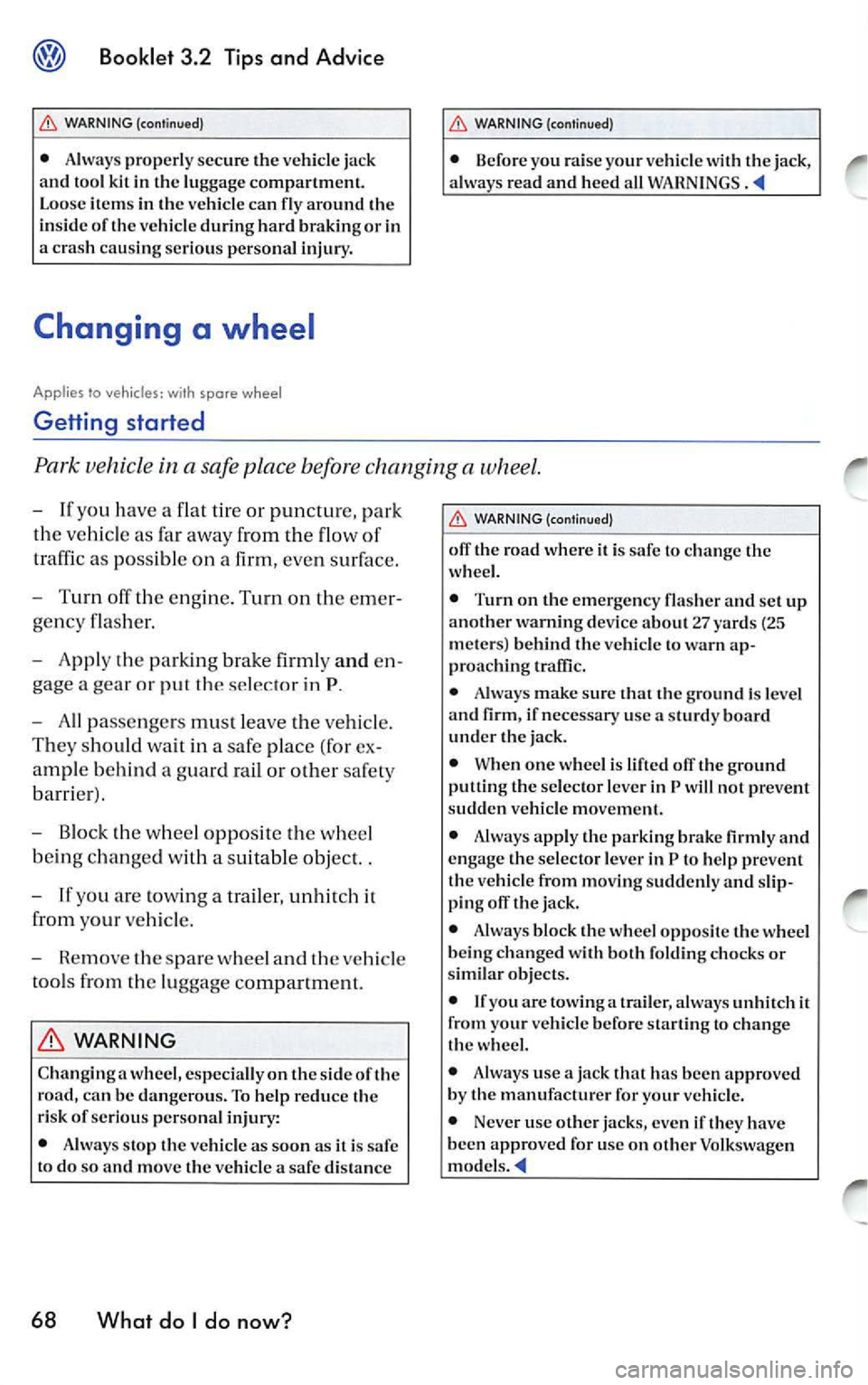
Booklet 3.2 Tips and Advice
WA RNING (continued)
• Always pro perl y s ecur e th e ve hicle ja ck
a nd t ool kit in th e lu ggage co mpartm ent.
L o ose item s in th e vehicle ca n fly a round th e
in sid e o f th e ve hicle during hard brakin g or in
a c rash cau sing seriou s pers onal injur y.
Changing a wheel
Applies lo vehicles: with spare wheel
Getting started
WARNING (contin ued)
• Before y ou rai se yo ur ve hicl e the jac k,
al ways re ad and h eed all
Pa rk vehicle in a safe place befo re changing a whee l.
-If yo u have a flat tir e or pun ctur e, park
t h e ve hicle as fa r away from th e flow of
t ra ffi c as poss ible o n a firm , eve n surf ace.
- Turn o ff the engine. Turn o n the emer
ge ncy flas her.
- Apply the park ing brake firm ly and en
gage a gear or
pu 1 1h e se lecto r in P.
- A ll passe nge rs mus t leave the ve hicle.
Th ey sh o uld wait in a safe place (for ex
a mpl e behin d a g ua rd rail or other safe ty
ba rrier) .
- Block the w hee l o pp osite t he w hee l
b ein g cha nged wit h a su itabl e objec t. .
- If yo u are tow ing a tra iler, u nh itch it
fr om your ve hicle .
- Remove the spare w hee l and the ve hicle
t oo ls from t he lu ggage com part ment.
WARNING
C han gin g a w hee l, es pecia lly on the s ide the
ro ad , can b e da ngero us. To hel p re du ce th e
ri sk of seriou s perso nal inju ry:
• Alw ays sto p th e vehicl e as soon as
is safe
t o do so and mo ve the ve hicle a safe distan ce
68 What do I do now?
WA RNING (cont inu ed)
off th e ro ad wher e it i s safe lo c hang e th e
wh eel.
• Turn on th e emerge ncy flas her a nd set up
an other warnin g dev ice a bo ut 27 ya rds (25
m eters) behin d th e ve hicl e to wa rn ap
pro achin g traffi c.
• Always make sure th at th e gro und i s leve l
a nd
if n ecessary use a s turdy boar d
und er th e jac k.
• When one w heel is lif ted
th e g round
puttin g th e se lector leve r in P will not pre vent
s udd en ve hicl e mo vement .
• Always appl y th e parkin g brak e
and
e ngage the se lec tor lever in P to help prev ent
the vehicl e from m oving s udd enl y a nd s lip
p in g o ff th e ja ck.
• Always block the whee l oppos ite th e w hee l
be in g cha nged with b oth fo ld in g ch ocks or
s imil ar obj ec ts .
• If you arc towin g a tra iler, a lways unhit ch it
fr om yo ur vehicl e before star tin g to c hange
th e w hee l.
• Alwa ys use a ja ck th at ha s bee n approve d
b y th e m anufa ctur er for your vehicle .
• Neve r u se oth er j ac ks, ev en if th ey have
b ee n ap pro ve d for u se on oth er Vo lkswag en
Page 390 of 477
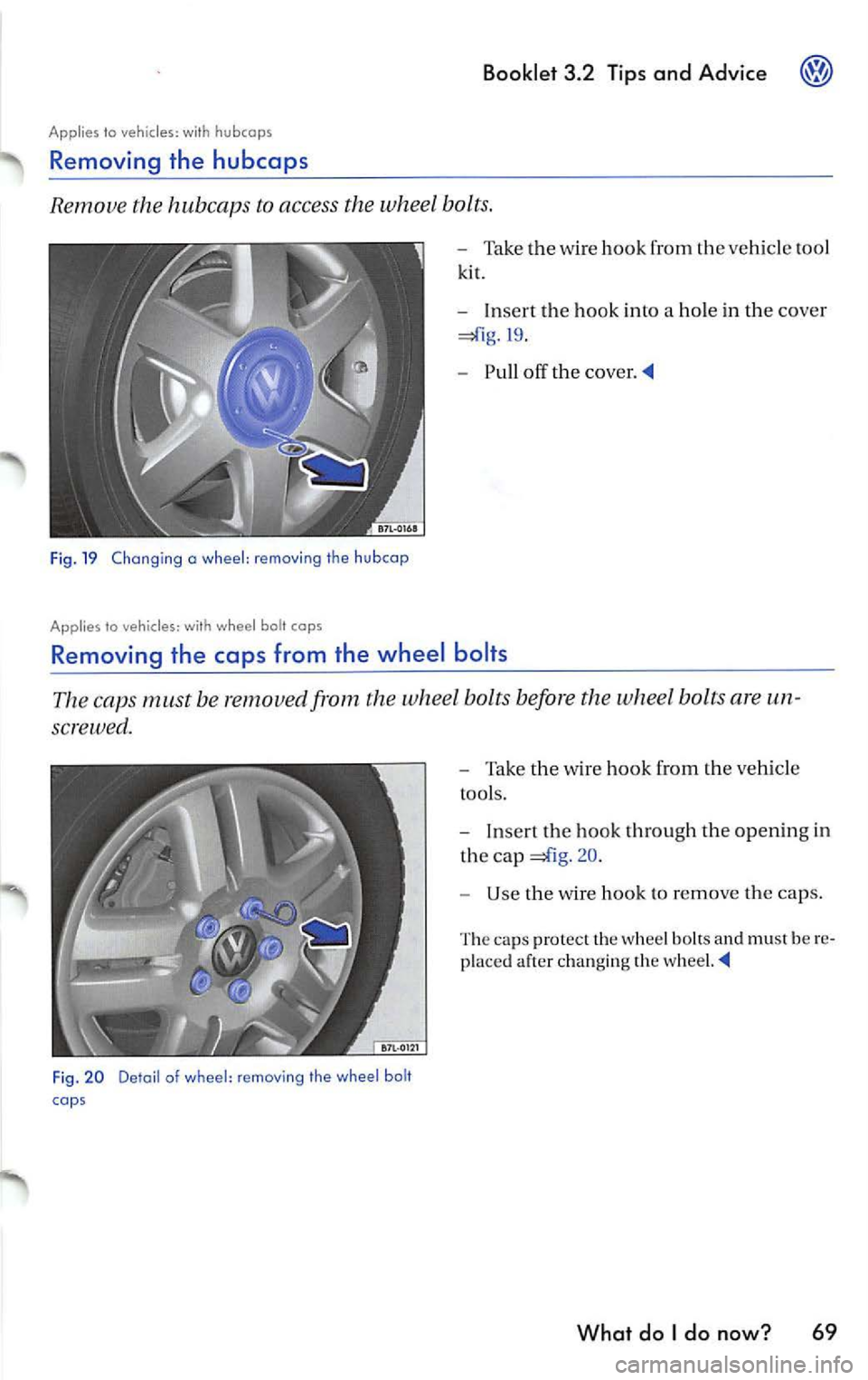
Booklet 3.2 Tips and Advice
Applies to veh icles: h ubc aps
Removing the hubcaps
Remove the hubcaps to access the whee l bolts.
Fi g. 19 Changing a wheel : removi ng th e hubcap
Applies to vehicles: with whee l bo lt cops
Take the wire hook from th e vehicle too l
ki t.
In sert the hook into a hole in the cover
Pull off the cover.
Removing the caps from the wheel bolts
The caps must be removed from the wheel bolts before the wheel bolts are un
sc rewed .
Fig . 20 Detail of wheel: removing the whe el bo lt
co ps
Take the wire hook from the vehicle
too ls.
I n sert th e hook through the open ing in
the cap
20.
Use the wire hook to remove the caps.
The ca ps pr otect the wheel an d must be re
p laced a fter c hanging the wheel.
What do I do now? 69